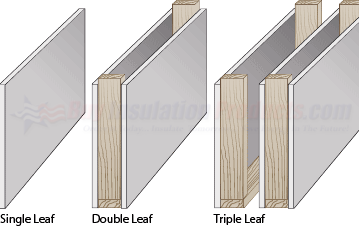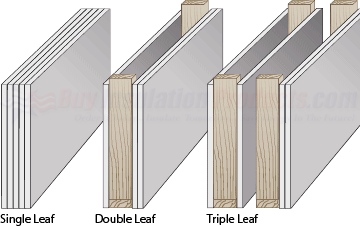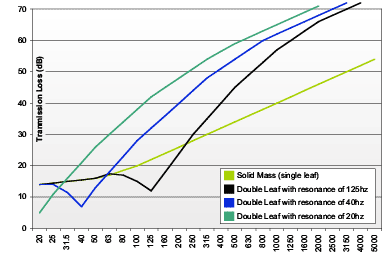Key to Soundproofing: Avoiding the Triple Leaf Effect
Posted by BIP on 14th Mar 2016
THE TRIPLE LEAF EFFECT:
If you are doing research on soundproofing walls, ceilings, and floors you will come across the mentioning of the "Triple Leaf Effect". You may or may not know, but building a wall/ceiling with three "leaves" is very bad for soundproofing.
So what is the triple leaf effect? It's not that complicated, its actually rather simple but in this post we will spell it out clearly.
LAYMAN'S TERMS:
A triple leaf wall is a wall that has two air gaps rather than the standard one air gap. Think of your basic wall, it is a 2x4 wood stud structure with a layer of drywall on both sides. This wall has one air gap, the space of the 2x4 studs. A triple leaf wall will have an additional air gap. For example, if you were to build a new 2x4 stud wall in front of your existing wall and add a layer of drywall to it, you would now have two air gaps. (see image below)

CONFUSION ALERT!:
One point that is somewhat confusing; if you add another layer of drywall to your existing Double Leaf wall, it is NOT a "third" leaf because there is no additional air gap. Also, adding this additional layer of drywall with Green Glue Noiseproofing Compound is also not an additional leaf (because any air space is filled with the Green Glue compound). See the image below: five layers of drywall is still considered a Single Leaf. The middle wall in the image below is the example we mentioned with one additional layer of drywall, yet its still considered a Double Leaf because there is still only one air gap.

SO WHY IS A TRIPLE LEAF STRUCTURE SO BAD FOR SOUND?
It seems like common sense that the triple leaf wall shown above would be better at blocking sound than the double leaf wall. Well, while this makes sense, it is very false, especially at low frequencies. To understand why this is, we have to take a look at how decoupling works.
Decoupling is not effective at all frequencies. If you take two layers of drywall, and separate them with an air space, it doesn’t improve things at all frequencies. The air in the cavity acts like a spring, and creates a resonance. Only well above this resonance do things improve (but then they improve very nicely indeed). Take a look at the graph below.

In the graph above we see the sound-stopping power of the wall, in decibels, at different frequencies. This is called “transmission loss”. While this data is hypothetical, this is what occurs in real walls – the decoupling has a large positive effect at high frequencies, but a negative effect around the resonance. So how do you avoid the triple leaf effect?
To attain good low frequency performance, this resonance must be as low in frequency as possible – otherwise the weak point of your wall will fall at an unfavorable location, and low frequency noise will have little trouble passing through the wall. The goal of any decoupled wall should be to drive resonance down in frequency.
To do this you have to:
1. Add mass to one or both sides of the wall
2. Increase the depth of the air cavity
3. Add soundproofing wall insulation (if not yet insulated)
AVOID A TRIPLE LEAF WALL TO LOWER THE POINT OF RESONANCE:
For a given amount of mass and space, triple leaf walls always have a higher resonance point than a double leaf wall.
One of the criteria that were given above for getting a low resonance point, and good low frequency performance was a deep air space, with a lot of mass on either side. The double leaf wall might have an air cavity depth of 8”, but for the same overall net wall depth, the triple leaf wall’s cavity will be just half that (4").
To make matters worse, each leaf in the double leaf wall is very heavy, but each leaf in the quadruple leaf wall is far lighter, half the mass. This will cause resonance to go up in frequency even more, and low frequency performance will be badly degraded.
Because there are multiple air gaps, the wall will have multiple resonances and possibly even more severe resonances. To further complicate things, a triple or quadruple leaf wall may exhibit more than one low frequency resonance – and if one is bad, then two or more are surely even worse.
CONFUSION ALERT:
In this post we discuss a triple leaf wall as being bad for sound when compared to a double leaf wall. The same goes for quadruple leaf walls and walls with even more air cavities. If a triple leaf wall is bad, a quadruple leaf wall is even worse, so please make sure to keep your walls, ceilings, and floors all double leaf structures and use soundproof wall insulation whenever possible.
ADDITIONAL BLOG POSTS RELATED TO THIS ONE:
Keys To Wall Soundproofing: Lesson 1 Decoupling
Green Glue Can Help You Easily Noiseproof Your Apartment Walls
Should I Use Green Glue Tubes or Pails?
What is Green Glue Noiseproofing Compound and How Does It Work?
Size of Hat Channel For Use With Green Glue Noiseproofing Whisper Clips
How to Properly Install Green Glue Noiseproofing Whisper Clips
Best Soundproof Ceiling Options with Green Glue


